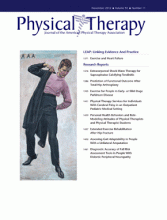Abstract
Background Extracorporeal shock-wave therapy (ESWT) represents a valid intervention in the treatment of people with supraspinatus calcifying tendinitis (SCT), but there is limited evidence for the useful range of ESWT doses.
Objective The aim of this study was to compare 2 different ranges of energy flux density in treatment of SCT with ESWT.
Design This study was designed as a single-blind randomized clinical trial.
Setting This study was performed in a university hospital.
Patients Forty-six patients with SCT were randomly assigned to 2 groups that received different therapeutic energy doses of ESWT: (1) group A received ESWT at an energy level of 0.20 mJ/mm2, and (2) group B received ESWT at an energy level of 0.10 mJ/mm2.
Intervention The treatment protocol consisted of 4 sessions performed once a week.
Measurements The change in mean Constant Murley Scale (CMS) scores at 3 and 6 months was the primary endpoint. The change in the mean visual analog scale (VAS) scores from baseline to 3 and 6 months after the intervention and radiographic change in size of calcium deposits were evaluated as secondary endpoints. At 12 months, pain relief was assessed using a numeric rating scale.
Results Significant clinical improvement based on mean CMS scores was observed after 6 months in group A (X̅=79.43, SD=10.33) compared with group B (X̅=57.91, SD=6.53). Likewise, after 6 months, a significant decrease in VAS scores was found in group A (X̅=2.09, SD=1.54) compared with group B (X̅=5.36, SD=0.78). Calcific deposits disappeared in the same percentage of patients in both groups.
Limitations The small sample size and lack of a control group were limitations of the study.
Conclusions In ESWT for SCT, an energy level of 0.20 mJ/mm2 appears to be more effective than an energy level of 0.10 mJ/mm2 in pain relief and functional improvement.
Footnotes
Dr Ioppolo, Dr Tattoli, Dr Di Sante, Prof Cacchio, and Prof Santilli provided concept/idea/research design. Dr Ioppolo, Dr Tattoli, Dr Di Sante, Dr Venditto, Dr Servidio, and Prof Cacchio provided writing. Dr Tattoli and Dr Di Sante provided data collection. Dr Tattoli, Dr Di Sante, and Dr Attanasi provided data analysis. Dr Ioppolo, Dr Attanasi, and Prof Santilli provided project management. Dr Attanasi and Dr Venditto provided facilities/equipment. Dr Di Sante, Prof Cacchio, and Prof Santilli provided consultation (including review of manuscript before submission).
This study was approved by the local ethics commission.
This study was supported by a grant from “La Sapienza” University of Rome.
ClinicalTrials.gov Identifier: NCT01602653.
- Received June 13, 2011.
- Accepted June 21, 2012.












